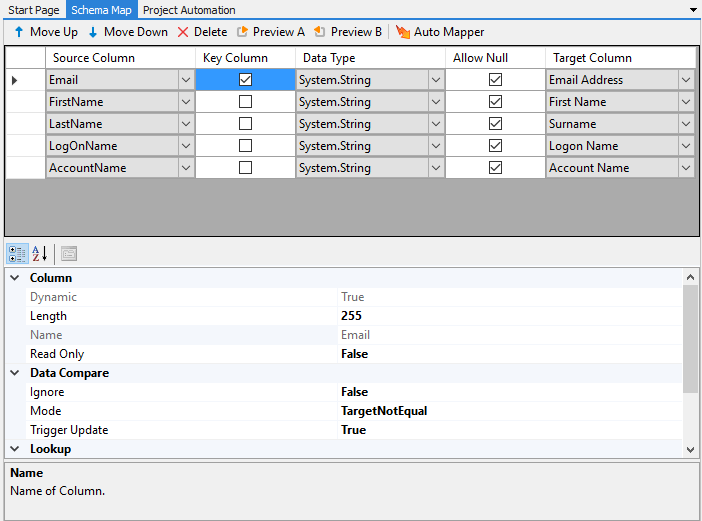Schema Map
The Schema Map in Data Sync is the connection between your Source and Target Data. This maps columns between the Data Sources and provides Data Type conversions.
The basic concept is that you model your Source Data how you want it to appear on the Target, Data Sync works out how to make them the same.
The Schema Map requires a Unique Key Column this is how Data Sync will decide if a ADD/UPDATE/DELETE action is created. If the Key is only in the Source (A) then it's a ADD action, if it exists in both Source (A) and Target (B) it's an UPDATE Action, if it only Exists in the Target (B) then it's a DELETE action.
The Key Column can be a composite key (multiple columns) in this case the value(s) from these columns are combined to create a Unique Key value.
If your Data Source returns multiple rows for the same Key value, they are flagged as duplicates and the duplicate items are removed from the compare. Only the first row with a given Key value is part of the compare and sync.
Each column in the Schema Map defines a Data Type, when the Data Source is loaded the incoming Data is converted into this Data Type and during the compare phase these Data values are compared based on the Data Type.
This is useful where your source my have a True/False value that you need to map to a SQL Integer Field. If your Source returns "Yes" or "No" text values, setting the Data Type to System.Boolean will automatically convert the value to 0 or 1.

To add rows the Schema Map simply check them in the Data Source window.
You can use Drag and Drop to edit the Schema Map, simply drag a column from the Data Source over the mapping.
Most of the Data Connectors are optimised so only the columns defined in the Schema Map are returned from the Target. Therefore for best performance you should limit the mapping to only the columns your working with.
The Schema Map can support many columns (500) however the wider your data set the slower everything is.
